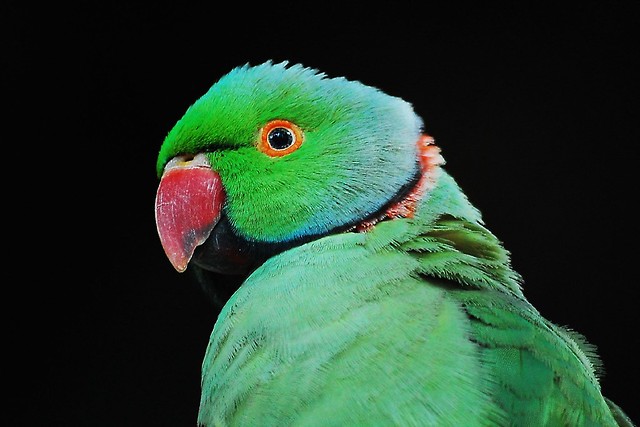 |
| Photo by challiyan |
We don’t have a flock, we have one small Indian Ringneck - Sunshine. Sunshine is 17. Catherine acquired him as a baby. He loves being with mom. We know about traveling with a bird. At home, he has a 30 x 30 California cage, a large playstand in the dining room and another playstand in the kitchen. Every workday Sunshine climbs into his custom, 18-inch long carrier and comes to work with us.
We open the carrier, he climbs up his Booda perch into his 26 x 20 HQ cage and finishes breakfast. Afterwards, he’ll walk back out via the Booda perch onto his King’s acrylic playstand. When he gets bored he fly’s onto his Prevue playstand or his Prevue 20 x 20 wire cage where he’ll stand so he can watch mom oversee the shipping of packages to our customers.
We spend many of our summer weekends at a campground. When we get there he usually goes right into his 18 x 18 Prevue cage. We modified our small travel trailer so the cage fits nicely into a closet where we removed the top of the door and provided a gentle light. When we’re outside the trailer, we have a large canopy/tent where Sunshine spends time in his 32 x 21 HQ aviary under the canvas. He always has one side of his cage against a wall for his own privacy.
If you’ve been following my notes, you’ll see our little 3-ounce bird has 10 cages and stands. We’ve never had a problem getting him into a new cage because
1) we don’t make of an issue of it and
2) he’s happy just to be with us.
A travel cage can be metal, fabric or plastic like - rigid or collapsible. Because it’s a travel cage only makes it slightly different than his home cage. If its metal, bar spacing should be appropriate. If it’s fabric, the fabric should be durable enough and well designed to discourage chewing. Clear plastic cages allow for great vision but may be confining for extended travel periods. It may only have one perch instead of three or four. Make sure it’s comfortable on the feet. Stopping and starting in traffic should not cause your bird discomfort. A couple of small toys should be introduced to keep birdie boredom down. If you’re traveling by auto, keep the bird in the back seat away from airbags in case of “god-forbids.” Keep it strapped with a seatbelt to avoid sudden movement.
If your driving at night, cover the cage, the intermittent glare of auto lights can be scary, especially if it's after bedtime. If you’re taking a road trip stopping at motels, find a place to put the travel cage where you bird can sleep with as little disturbance as possible through the night. We usually find the bathroom counter to be the best spot, it’s out of the way and once the cage is covered, affords privacy. In terms of temperature, it’s simple - if your comfortable, your bird is comfortable. No hot cars with the window cracked or in front of air conditioners in hotel rooms.
If traveling for the first time, we suggest a few trial runs before the big trip. Go to friends, the vet or even just a ride, the bird gets accustomed to the procedure, travel process and change in general. If you let the bird out of the travel cage while in the vehicle don’t forget to put him back before any passengers open the door. Some birds don’t like to poop in their travel cage. This is a judgment call. Choose carefully where you’ll let them out to poop. You also may want to check out the nearest avian vet to your destination, before you get there - just so you have the info.
Remember. birds in the wild are natural travelers. Larger birds will fly 50 or miles per day seeking food. Many migrate thousands of miles twice annually. It’s usually less of an issue for the bird than for you. Lastly, we know you love showing off your bird. Unknown places would not be the time to do it. Unscrupulous people may have ulterior motives. While traveling with your bird it’s no one's business but your own.Have a great trip
Mitch Rezman
www.windycityparrot.com
|

No comments:
Post a Comment